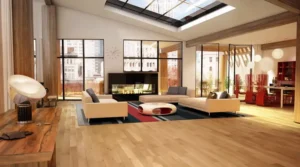How Many Floors Are There in Burj Khalifa? – And What’s Inside Them?
When you think of Dubai’s skyline, one image towers above all: the shimmering spire of Burj Khalifa. Known globally as the tallest building in the world, the Burj Khalifa is more than just an engineering marvel. It’s a vertical city packed with luxury, ambition, and mind-boggling technical achievements. But the real question that fascinates millions is: How many floors does the Burj Khalifa actually have? And equally intriguing: what’s hidden inside them? Let us take you on a verbal tour inside this sprawling tower for a detailed look.
How Many Floors Are in Burj Khalifa?
The Burj Khalifa boasts 163 floors above ground dedicated to residential, commercial, and leisure use. Additionally, it features 2 extra levels below ground, primarily used for parking and building services. Altogether, the building technically spans over 200 floors when you include mechanical and non-habitable maintenance levels. A Flooring Expert in Dubai who once worked on the project noted, “Each floor in the Burj Khalifa required precision that matched the standards of a five-star resort. The smallest detail had to embody perfection, considering the world’s eyes would always be watching.” That craftsmanship is evident from the ground level to the tip of its soaring spire.
Quick Snapshot of Burj Khalifa
Its height is 828 meters or 2,717 feet with 163 floors above ground. There are 2 basement levels, and the total built-up area is approximately 5.67 million square feet. The design was made by the world-renowned architect, Adrian Smith, alongside Skidmore, Owings & Merrill. Emaar Properties took charge of the development of this mega structure with a construction period ranging from 2004 to 2010. The construction was done in 2010, and the opening date was January 4, 2010
The Inspiration Behind the Burj Khalifa
The Burj Khalifa isn’t just a tall structure; it’s a symbol of what’s possible when ambition meets technology. Its design was inspired by the regional desert flower, the Hymenocallis, with a triple-lobed footprint. This flower’s structure provides Burj Khalifa the optimal stability against Dubai’s frequent gusts.
The tower’s shiny exterior is a result of its reflective glazing and aluminum. They were used so that they could combat Dubai’s extreme heat. Beneath its beautiful shell lies a brilliant design strategy that ensures its impressive performance in having temperature control and resisting earthquakes.
Distribution of Floors and Their Uses
Each zone of the Burj Khalifa serves a distinct purpose. This makes it a truly self-contained vertical city in its own right. Here’s how the floors are distributed:
| Floor Range | Purpose |
| Ground to Level 8 | Armani Hotel Dubai (luxury hotel suites) |
| Level 9 to Level 16 | Armani Residences (private apartments) |
| Level 17 and 18 | Mechanical Floors |
| Level 19 to Level 108 | Residential Apartments |
| Level 109 to Level 154 | Corporate Suites (offices) |
| Level 155 to Level 159 | Communications and Broadcast Equipment |
| Level 160 to 163 | Mechanical Spaces |
| Above Level 163 | Spire and Maintenance Levels |
There are also several observation decks, restaurants, and lounges scattered throughout the upper middle levels.
1. The Iconic Armani Hotel (Ground to Level 8)
At the base of the Burj Khalifa, the first eight floors are dedicated to the opulent Armani Hotel Dubai. This is a luxurious hospitality venture personally designed by Giorgio Armani. Every element inside this hotel, from the stone flooring to the furniture, speaks simplicity with an understated sophistication.
The flooring uses premium Italian marble and carefully chosen textiles that bring out natural warmth despite the tower’s modern exterior. Collaborating with an Interior Designer Dubai team, Armani created a flawless blend of fashion and architecture, setting the tone for the entire tower.
2. Residential Apartments (Level 19 to Level 108)
From the 19th to the 108th floor, the Burj Khalifa is home to 900 exclusive private residences. These apartments range from elegant one-bedroom units to magnificent four-bedroom suites.
Residents can enjoy the panoramic views of Dubai’s skyline, desert, and sea and have access to various amenities. These include private gyms, luxurious indoor and outdoor swimming pools, health and wellness centers. The residential areas use polished stone floors, plush carpeting, and bespoke wood paneling — materials that mirror the building’s unmatched stature.
3. Corporate Suites (Level 109 to 154)
Above the residential floors, the Burj Khalifa transitions into the world’s most prestigious business address. The corporate suites occupy levels 109 to 154 and cater to multinational giants, elite investment firms, and entrepreneurial ventures.
Each floor offers customizable office layouts with advanced telecommunication systems. There are also the Executive lounges with Meeting facilities that feature floor-to-ceiling glass walls showcasing breathtaking views of Dubai. Setting up a business here isn’t just about renting an office; it’s about being part of the elite ecosystem that defines Dubai’s business culture.
4. Communications and Mechanical Floors (Level 155 to 163)
While visitors never see these levels, they are vital to the building’s operations. They house broadcasting equipment, communication devices, and critical mechanical systems like water storage, HVAC units, and elevator motors. The Burj Khalifa’s high-speed double-deck elevators, capable of traveling up to 10 meters per second, are powered and maintained from these spaces.
5. Observation Decks: At The Top and Beyond
For visitors, the highlight of Burj Khalifa is going to the observation decks. There are 3 observation decks at Burj Khalifa, which are at:
- At The Top (Levels 124 and 125): It offers visitors panoramic views and educational exhibits about the building’s construction.
- At The Top SKY (Level 148): This was once known as the world’s highest observation deck.
- The Lounge (Levels 152–154): This is currently the highest lounge in the world, where they offer afternoon tea while you have a stunning sunset experience.
These levels feature specially reinforced flooring to handle heavy visitor footfall and are adorned with local art, providing both beauty and resilience.
6. Dining in the Clouds: At.mosphere (Level 122)
Situated on the 122nd floor, At.mosphere is not just a restaurant — it’s an experience. It offers fine dining 442 meters above the ground. With award-winning cuisine, a luxury atmosphere, and unbeatable views, dining here feels like floating among the clouds.
A Fun fact about The Lounge is that you can not only enjoy having high tea but also lunch, or a Michelin-star-worthy dinner while watching over the Arabian Gulf!
7. Secrets of the Sky: Above Level 163
Above the 163rd floor, Burj Khalifa transforms into a purely functional structure known as The Spire. It’s largely made of steel – the spire itself accounts for nearly 29% of the Burj’s total height. It contains maintenance equipment, communication antennas, and aircraft warning lights Access here is restricted to maintenance teams and structural engineers. Despite being off-limits to the public, these levels play a crucial role in maintaining the building’s global communications.
Architectural and Engineering Feats
Burj Khalifa’s design had to overcome serious climate challenges, common in Dubai, like:
- Wind resistance: A series of setbacks in its spiral shape reduce the wind load.
- Temperature extremes: Special glazing and insulation reduce solar heat gain.
- Concrete strength: The building’s high-performance concrete is designed to withstand Dubai’s summer temperatures.
To ensure the structure’s integrity, sophisticated surveying equipment constantly monitors the tower’s movement, which can sway by up to 1.5 meters at its highest point.
Sustainability Measures
Despite its size, Burj Khalifa incorporates eco-friendly initiatives:
- A condensate collection system gathers moisture from air-conditioning systems, supplying about 15 million gallons of water annually for irrigation.
- High-efficiency lighting systems reduce energy consumption.
- Smart building management systems optimize cooling and ventilation.
Burj Khalifa stands not just as an icon of luxury but also as a forward-thinking structure aligned with modern sustainability goals.
The Role of Flooring and Interior Craftsmanship
Every inch of the Burj Khalifa has been carefully crafted, with flooring being a major part of its aesthetic appeal. Flooring experts in Dubai were involved in creating surfaces that are not only luxurious but also durable enough to handle millions of footsteps every year.
From Italian travertine stone to hand-made carpets to custom wood veneers, each space inside the Burj Khalifa feels different yet unified. The flooring transitions, material choices, and textures contribute highly to the guest experience, whether it’s in the Armani Hotel, a private residence, or a corporate suite.
Best Time to Visit Burj Khalifa
If you’re planning a visit to the Burj Khalifa, timing matters!. Plan your trip after Sunset hours to get that stunning golden hour for photography. Beware that this is known by many tourists and there can be large crowds. Another time is Early morning on weekdays, when there are fewer visitors, giving you a more relaxed experience. Booking your tickets online in advance saves time and money. Premium ticket holders can access the SKY Lounge and enjoy a more private tour of the observation decks.
Why Burj Khalifa Remains Unchallenged
The Burj Khalifa isn’t just a tall building; it’s a global cultural phenomenon.
It holds multiple world records in the following categories.
- The tallest building in the world
- The tallest freestanding structure
- The highest number of stories
- The highest outdoor observation deck
- The tallest service elevator
Above all, it has become a symbol of human ingenuity and Dubai’s rapid ascent on the world stage.
Conclusion
So, how many floors does the Burj Khalifa have? Technically speaking, 163 habitable floors, plus mechanical levels and underground parking. All of these are stacked into one architectural marvel that towers over the sky for nearly 828 meters. But the true magic of Burj Khalifa lies not just in its height or its floor count. It offers an incredible mix of art, engineering, luxury, and culture that fills every level. Whether you’re staying at the Armani Hotel, living in a private residence, working in a sky-high office, or simply visiting one of the observation decks, you are stepping into a living piece of human history. Burj Khalifa isn’t just a building; it’s an experience you carry with you forever.





